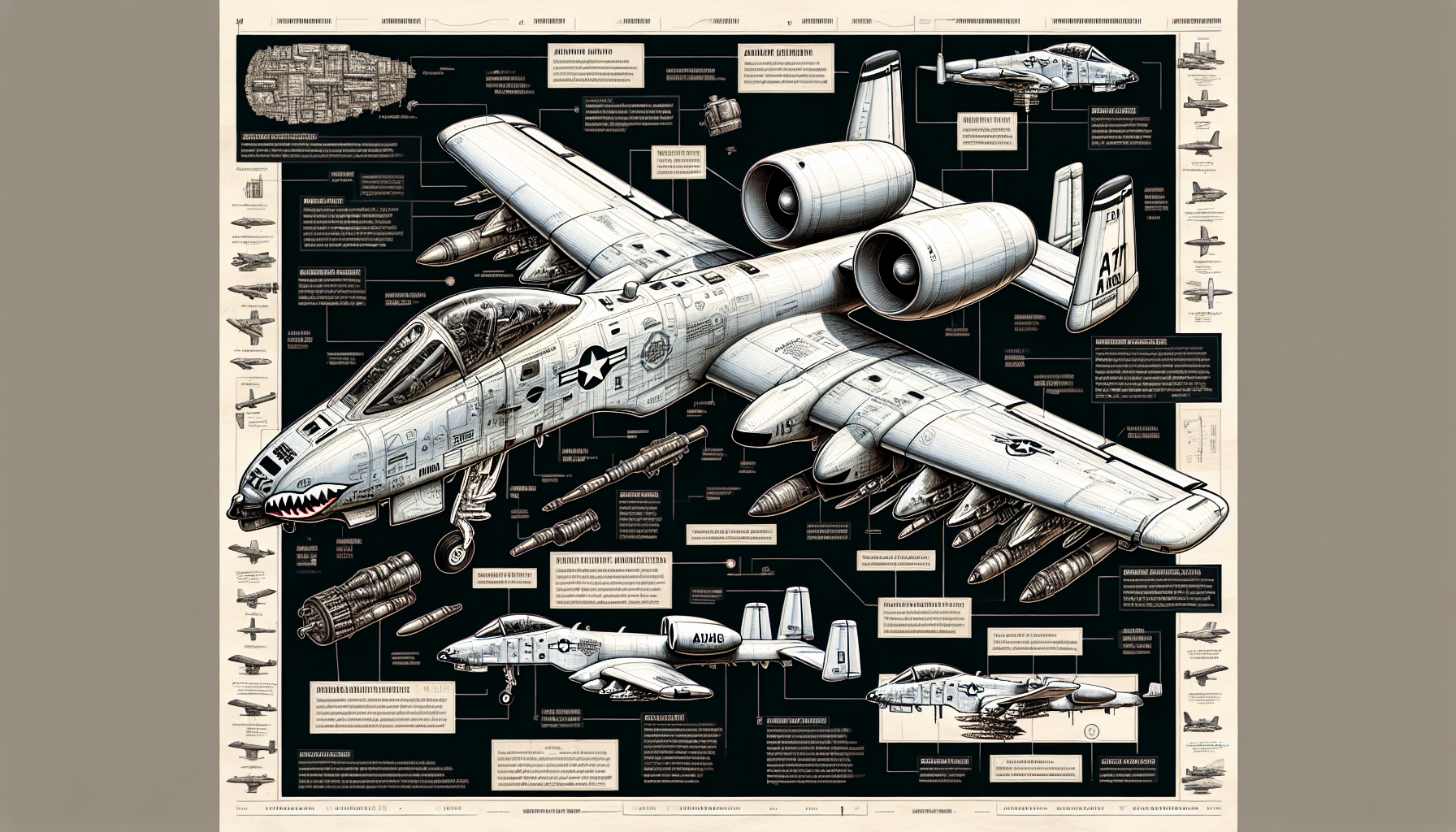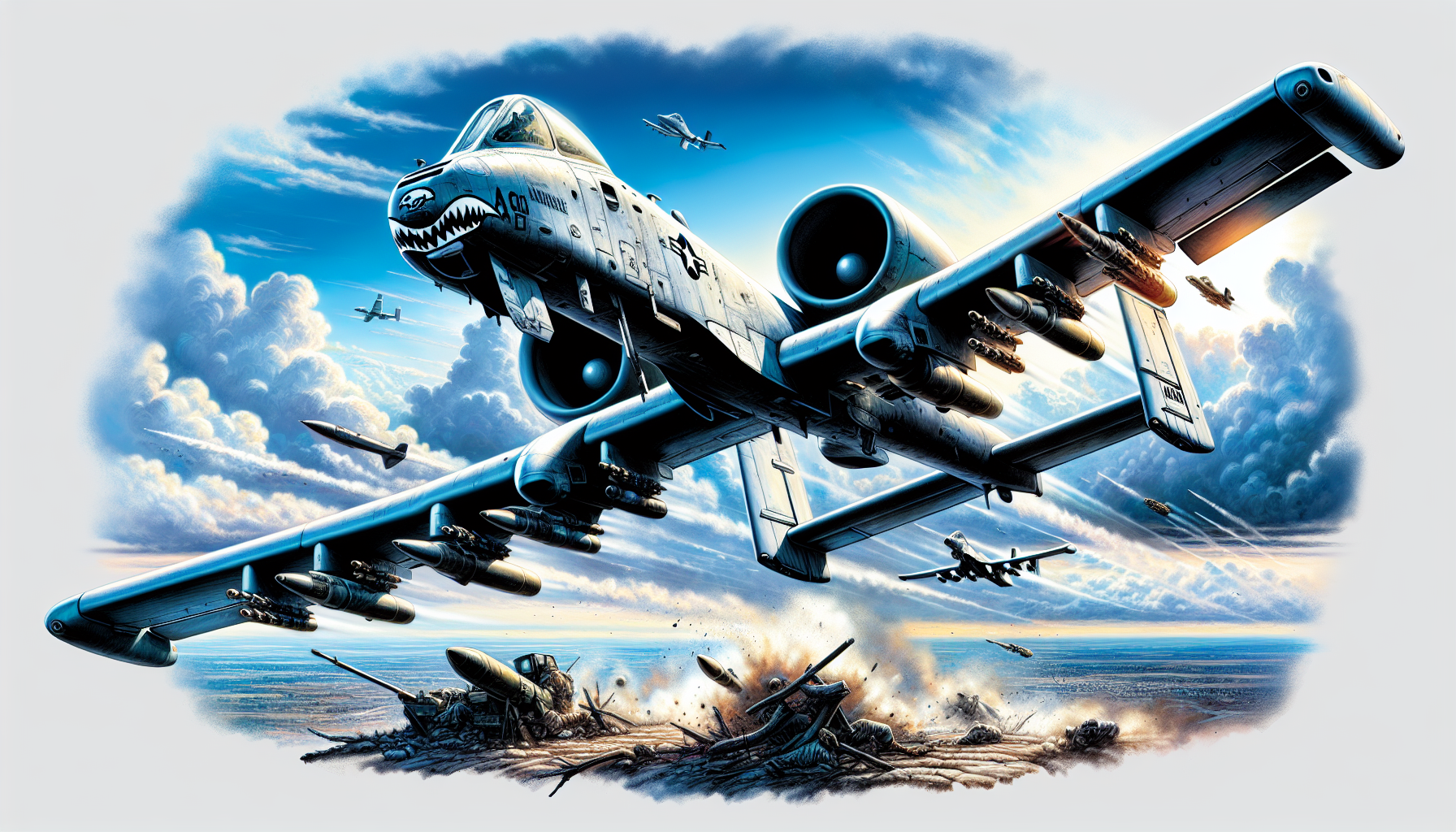A 10 Thunderbolt: Why This Aircraft Remains Essential
Why is the A-10 Thunderbolt still essential for the U.S. Air Force? Known for its durability and precision in close air support, the A-10 Thunderbolt stands out in modern combat. This article covers its development, unique features, and ongoing upgrades.
Key Takeaways
-
The A-10 Thunderbolt II, developed for close air support, has undergone significant modernization, including the introduction of the A-10C variant with enhanced avionics and targeting systems.
-
Its operational flexibility allows the A-10 to effectively support ground forces in austere environments, providing sustained air support and precision strikes with a diverse arsenal.
-
The A-10 is projected to remain in service until at least 2028, with ongoing upgrades reinforcing its critical role in modern combat despite discussions of potential replacements.
Development History of the A-10 Thunderbolt

The story of the A-10 Thunderbolt II begins in the conflict-laden skies of Vietnam, where the need for a robust close air support aircraft became glaringly apparent. As U.S. troops faced increasingly fortified ground targets, the military recognized the necessity for an aircraft that could withstand direct hits and continue delivering precise, devastating firepower. Enter the A-10, designed by Fairchild Republic to meet these exacting demands for the united states air force.
The A-10 had its maiden flight in May 1972, a milestone that marked the beginning of a new era in close air support. Over the next decade, a total of 713 units were produced, with production officially selected in 1973 and concluding in 1984. This extensive production run underscored the confidence the U.S. Air Force placed in the A-10’s capabilities and its role in modern combat scenarios.
A wing replacement program initiated in June 2007 aimed to extend the A-10’s operational life and enhance its performance. By August 2019, new wings had been installed on 173 aircraft, significantly improving their longevity. These new “Tusk” wings significantly improved the aircraft’s longevity, ensuring that the A-10 could continue to serve well into the future.
Boeing played a crucial role in the A-10’s modernization, securing multiple contracts, including a significant $4.2 million deal to enhance the aircraft’s capabilities. These upgrades have kept the aircraft relevant in an ever-evolving battlefield, allowing it to integrate new technologies and maintain its edge over adversaries.
The A-10C variant, introduced in 2007, represented a significant leap with advanced avionics, precision engagement capabilities, and improved combat effectiveness. This modernization ensured the A-10 remained formidable, capable of tackling contemporary threats with unprecedented efficiency.
Precision Engagement Upgrade Program
The A-10C variant represents a pinnacle of technological advancement, brought about through the Precision Engagement Upgrade Program. This initiative aimed to significantly enhance the operational capabilities of the A-10, ensuring it remained a lethal and reliable platform in modern warfare.
Under this ambitious program, a total of 356 A-10 aircraft were upgraded, reflecting a substantial commitment to maintaining the fleet’s effectiveness. The first upgraded A-10C took to the skies in January 2005, and by August 2007, it had achieved initial operating capability. This rapid development timeline highlights the urgency and importance placed on these upgrades.
Central to the A-10C’s enhancements are its advanced cockpit systems. Pilots now benefit from a head-up display, Have-Quick radio, inertial navigation, TACAN, EGI, and TERPROM for navigation and targeting. These systems collectively improve situational awareness, allowing A-10 pilots to execute missions with greater precision and safety.
One of the standout features of the upgraded A-10C is the integration of the Sniper XR targeting pod. This advanced system provides unparalleled targeting accuracy, enabling pilots to identify and engage ground targets with remarkable precision. The Sniper XR targeting pod, combined with the re-winging program, ensures that the A-10C remains a formidable force on the battlefield.
Mission Capabilities

The A-10 Thunderbolt II is renowned for its primary mission: close air support of ground forces. Designed to engage tanks, armored vehicles, and other ground targets, it excels in delivering precise, overwhelming firepower where it’s needed most. This capability is crucial for supporting frontline ground troops and disrupting enemy formations.
One of the A-10’s defining characteristics is its ability to operate in austere environments. This means it can be deployed from forward air bases, close to the front lines, providing rapid response to emerging threats. Its design allows for short take-off and landing, further enhancing its operational flexibility in challenging terrains.
The A-10’s operational flexibility is further underscored by its ability to loiter in combat zones for extended periods. This “linger and deliver” capability is vital for close air support missions, as it allows the aircraft to provide continuous coverage and respond to dynamic battlefield conditions. Its superior maneuverability at low speeds and altitudes, with visibility up to 2.4 kilometers, ensures that pilots can precisely target and engage ground threats.
In addition to its offensive capabilities, the A-10 is equipped with integrated flight control systems and jammer pods for defense. These systems enhance the aircraft’s survivability in hostile environments, allowing it to withstand and evade enemy fire while completing its mission objectives. The A-10’s robust design and advanced systems make it a formidable asset in any combat scenario.
Cockpit Features
The A-10 Thunderbolt II’s cockpit is a marvel of engineering, designed with pilot safety and mission effectiveness in mind. One of the most notable features is the titanium armor that shields the pilot and critical sections of the flight control system. This armor, with a thickness of 3.8 cm, provides substantial protection against enemy fire, allowing the aircraft to survive direct hits from projectiles up to 23mm in caliber.
The cockpit’s bubble canopy offers pilots a comprehensive field of vision, crucial for situational awareness during complex missions. This expansive view allows pilots to monitor the battlefield and engage targets with precision, enhancing the A-10’s effectiveness in close air support roles.
The A-10C variant has been equipped with advanced targeting pods, such as LITENING and Sniper, which significantly improve precision. These pods, along with enhanced cockpit displays and a moving map, provide pilots with real-time data and targeting information, streamlining mission execution and improving accuracy.
The A-10’s cockpit includes night vision imaging systems compatible with goggles, enabling pilots to conduct missions in low-visibility conditions and ensuring effectiveness around the clock. The inclusion of night-vision goggles further enhances the aircraft’s operational capabilities, allowing it to perform critical missions regardless of the time of day.
Armament and Weapon Systems

The A-10 Thunderbolt II’s armament is nothing short of formidable. It can carry a maximum of 16,000 pounds of mixed ordnance across eight under-wing and three under-fuselage pylon stations. This extensive capacity allows the A-10 to deliver a wide array of munitions, tailored to specific mission requirements.
At the heart of the A-10’s firepower is the General Dynamics GAU-8/A 30mm cannon. Mounted in the aircraft’s nose, this rotary cannon can discharge 3,900 rounds per minute and has an effective range exceeding 6,500 meters against armored targets. Its high rate of fire and destructive power make it exceptionally effective at neutralizing enemy armor and fortifications.
In addition to its cannon, the A-10 can carry up to ten AGM-65 Maverick missiles, designed for precision strikes. These missiles feature a high-penetration warhead weighing 57 kg, capable of destroying heavily fortified targets with surgical accuracy. The combination of the GAU-8/A and Maverick missiles ensures that the A-10 can tackle a variety of threats on the battlefield.
The A-10C variant further enhances its arsenal with GPS-guided munitions and laser-guided bombs. These advanced weapons systems improve target engagement accuracy, allowing the A-10 to deliver pinpoint strikes in complex combat environments. The aircraft is also equipped with electronic countermeasures and laser radiation systems to defend against enemy threats.
Engine Performance and Specifications
The A-10 Thunderbolt II’s performance is driven by its twin engines, each providing a thrust of 9,065 pounds. These engines enable the aircraft to achieve a maximum speed of 518 miles per hour, allowing it to rapidly respond to battlefield threats and reposition as needed.
With a combat range of approximately 800 miles, the A-10 can operate deep within enemy territory and provide sustained support to ground forces. This range can be extended through aerial refueling, ensuring that the A-10 remains in the fight for as long as necessary.
Its maximum operating altitude of 45,000 feet further enhances its versatility, allowing it to engage targets from a variety of altitudes and approaches.
Operational History
The A-10 Thunderbolt II has a storied operational history, having participated in numerous key military operations. Its first major deployment was during the Gulf War in 1991, where 132 A-10s were sent into combat. During Operation Desert Storm, the A-10s achieved a mission capable rate of 95.7 percent and launched 90 percent of the AGM-65 Maverick missiles fired. This impressive performance underscored the aircraft’s reliability and effectiveness in combat.
The A-10 continued to demonstrate its value in conflicts like Operations Iraqi Freedom and Enduring Freedom. Between 2006 and 2013, A-10s accounted for 32 percent of combat sorties, providing essential support to coalition forces. In 2014, A-10s were deployed against ISIL militants in Iraq, highlighting their ongoing relevance.
In March 2011, A-10s participated in Operation Odyssey Dawn in Libya, targeting Libyan ground forces and contributing to the mission’s success. The aircraft also played a significant role during the conflict in the Balkans, firing approximately 10,000 rounds of 30 mm ammunition between 1994 and 1995. These operations highlight the A-10’s versatility and enduring importance in a variety of combat scenarios.
Colors, Markings, and Nose Art

One of the unique aspects of the A-10 Thunderbolt II is its distinctive nose art, which adds character and reflects the individuality of different squadrons. This tradition of nose art dates back to World War II and has been carried forward by A-10 units, each adding their own flair and identity to their aircraft.
The designs, featuring animals, mythical creatures, and unique symbols, personalize the aircraft and boost squadron morale, reflecting the spirit and camaraderie of the pilots and ground crews.
Nose art serves as a visual testament to the aircraft’s rich history and the dedication of those who fly it. It embodies the pride and professionalism of the squadrons, making each A-10 a unique symbol of their collective efforts and achievements.
Aircraft Display Locations
The A-10 Thunderbolt II’s storied history and iconic design have made it a popular exhibit at various museums and airshows across the country. One notable location where the A-10 can be seen is the Steven F. Udvar-Hazy Center in Chantilly, Virginia, where it is part of a temporary outdoor display. This exhibition allows the public to get up close and appreciate the aircraft’s design and capabilities.
Beyond museums, the A-10 is regularly featured in public exhibitions and airshows, celebrating its role and contributions to military aviation. These events provide an opportunity for enthusiasts and the general public to witness the A-10 in action, often accompanied by flight demonstrations that showcase its impressive maneuverability and firepower.
The inclusion of the A-10 in these displays underscores its significance in aviation history. By showcasing the aircraft in educational contexts, these exhibitions honor its legacy and educate future generations about its pivotal role in modern warfare.
Modernization and Future Prospects

Looking to the future, the A-10 Thunderbolt II is projected to remain in service until at least 2028, with ongoing discussions about its potential replacement. This projection reflects the aircraft’s enduring value and the continuous efforts to modernize its systems and capabilities.
The A-10 has undergone various modernization efforts to enhance its operational relevance. These upgrades include advancements in avionics, targeting systems, and structural improvements, ensuring that the A-10 can meet contemporary combat challenges. These efforts are a testament to the aircraft’s robust design and adaptability.
Despite debates about its replacement, the A-10’s importance in modern combat scenarios remains clear. Its ability to provide close air support, coupled with its survivability and firepower, makes it a critical asset for the U.S. military. The discussions highlight the financial efficiency of maintaining and upgrading the A-10, as opposed to developing an entirely new platform.
Ultimately, the future of the A-10 Thunderbolt II will depend on the evolving needs of the military and the continued success of its modernization programs. As long as it remains effective and relevant, the A-10 will continue to be a cornerstone of the U.S. Air Force’s close air support capabilities.
Summary
In summary, the A-10 Thunderbolt II stands as a testament to robust design, relentless modernization, and unparalleled effectiveness in close air support roles. From its development during the Vietnam War era to its modern-day upgrades, the A-10 has proven its worth time and again on the battlefield. Its unique capabilities, including survivability, firepower, and operational flexibility, make it an indispensable asset for the United States Air Force.
As we look to the future, the A-10’s legacy will continue to be shaped by ongoing modernization efforts and its role in contemporary combat scenarios. Whether through its iconic nose art, public displays, or battlefield performance, the A-10 Thunderbolt II remains a symbol of military might and innovation. Its enduring presence in the skies is a tribute to the vision and dedication of those who designed, built, and fly this remarkable aircraft.
Frequently Asked Questions
What is the primary mission of the A-10 Thunderbolt II?
The primary mission of the A-10 Thunderbolt II is to provide close air support for ground forces by effectively targeting tanks, armored vehicles, and other ground threats.
How many A-10 aircraft were produced?
A total of 713 A-10 aircraft were produced between 1973 and 1984.
What upgrades were included in the Precision Engagement Upgrade Program?
The Precision Engagement Upgrade Program for the A-10C enhanced the aircraft with advanced cockpit systems, GPS and inertial navigation, and integrated the Sniper XR targeting pod, significantly improving targeting precision.
How does the A-10 Thunderbolt II protect its pilot?
The A-10 Thunderbolt II protects its pilot with a robust cockpit shielded by 3.8 cm thick titanium armor, designed to withstand 23mm projectiles. This exceptional protection enhances pilot safety during combat operations.
Where can the A-10 Thunderbolt II be seen on display?
The A-10 Thunderbolt II can be seen on display at the Steven F. Udvar-Hazy Center in Chantilly, Virginia, as well as during various airshows and public exhibitions.







